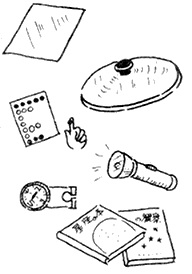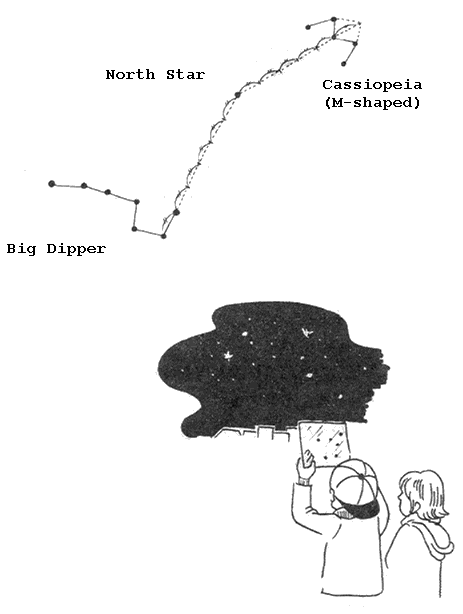Internet version [Naruhodo no Mori] Vol.23
by Yumiko Mori

Vol. 23 November, 15th, 1996


Mom cannot give up yet. She is still looking at the night sky.
Mom: "Tae! Come here! I can see stars now!"
Tae: "All right! I'm coming as soon as I put my jacket on."
Mom and Tae grab a glass lid and a flashlight, and go outside of the house.
Tae: "Mom, can we avoid anywhere too dark? It's scary.
We can see enough stars here."
Mom: "Can you see a house over there?
It has a rooftop.
That would be the best place to see stars.
I wish we had a rooftop like that on our house."
Tae: "The north is this way."
Mom: "We have to remember where we stand.
How about this manhole?
You position the North Star at the center of the lid."
Tae: "Put small stickers for visible stars.
Can I put a sticker on that reddish flickering star?"
Mom: "That is really beautiful one."
10 o'clock at night.
Tae and Mom go out with the lid, on which they marked positions at 8 o'clock.
Tae: "Oh! Stars are now at completely different positions."
Mom: "How about this one?"
While stars in the eastern sky moved quite far, the Cassiopeia constellation moved only slightly to the left.
Tae: "Mom, doesn't that star move?"
Mom: "North Star? Actually it is moving on a very small circle.
No, actually the star is not moving but our earth is rotating instead."
Tae: "You mean some stars move by longer distances, but the other stars move only short distances.
That's interesting!"
Mom: "Yes, but it is again because the earth is rotating.
Well...I am getting confused completely."

| A few plastic boards | |
| A glass lid | The bigger, the better. You could use a plastic board instead. |
| Small stickers | Round shapes with various color |
| A flashlight | |
| A magnet compass | |
| You may want to borrow a few books describing seasonal constellations from your nearby library. | |
| You'd better dress warm if it's cold outside. | |

There is a science museum near my parents' house. When we visited there, I saw a model in which the positions of the Big Dipper stars are presented in 3D map (a view of the Big Dipper from very far away from the Earth). I learned that the 7 stars that form the Big Dipper are not lined up at the same distance from the earth. Some of the stars are closer, while the others are far from the earth. I realized constellations are meaningless for aliens on other planets. Ancient people had to depend on stars for their calendar. They must have stared nightly sky for many times as we look at our wall calendars, Today it is difficult to see stars in cities because of city lights. Ironically we have lost necessity for looking up stars every night.
| Author | Yumiko Mori (Zushi, Kanagawa, Japan) |
|---|---|
| Illustration | Mitsue Ogata |
| Translator | Akira Ishihara |
| HTML format | Muneo Kume |

